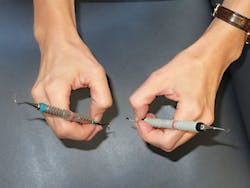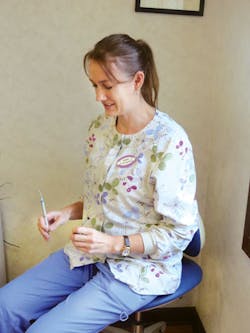Both hands: Southpaw dental hygienist explains why she started working from both sides of the chair
By Amber Sanchez, RDH, BA
All my life, I've been known as a standout, one who does things differently than most. So dental hygiene school was no exception. I stood out from the crowd right away. This happens to be because I'm left-handed. As a population, 90% of people are right-handed, so their way of doing things typically prevails. I have lived in a world designed for right-handed people for a long time now, and I've learned that flexibility is the key. Learning dental hygiene was no exception to this rule.
When starting my dental hygiene education in the fall of 2002, reality finally hit me. I was the outcast. I didn't fit in. My instructors had trouble explaining positioning to me. When we were first introduced to scalers, I was required to work right handed for the first two months. The reasoning was that it would be easier to teach everyone the same way. This was a very long and awkward two months for me! I've never been a very hands-on person, so being forced to use my right hand made a difficult situation feel tumultuous. But I pushed ahead and when I was allowed to work left-handed, I learned that I had developed the ability to work with both hands.
This two handed revelation really confused and amused my instructors. They found it complicated to explain any positioning to me, and many times I felt like I was on my own when it came to figuring out how to remove calculus from a stubborn area. I remember many days in the clinic being the last student left, working on a patient and feeling completely frustrated. Fortunately, everything began to click after a while, and over time this method of working has truly become second nature to me.
I literally work from both sides of the chair. When I'm on the right side of my patient, I clean everything that is easy to access from the right side (the upper left linguals, the upper right buccals, the lower left linguals, and lower right buccals). When I'm on the left side of my patient, I work on the opposite sides of the posterior teeth (the maxillary left buccals, the maxillary right linguals, the mandibular left buccals, and the mandibular right linguals). As far as the anterior teeth, I tend to work with my right hand from the 12 o'clock position, but I do switch back and forth between hands as I feel the need with more difficult patients. I can perform a complete prophy working right-handed if needed, but I definitely prefer to work with both hands when it comes to calculus removal.
No Mirror
As a result of this positioning, I can see almost everything with direct vision. The only exception is the lingual surfaces of the anterior teeth. I really love not having to look through a tiny mirror most of the time as I truly feel it makes my visualization more effortless. I do not have to make patients turn their heads very often either. Most of the time patients do not even notice when I switch sides of the chair. It is very rare that I actually have a patient figure out that I work both left- and right-handed.
Working as an ambidextrous dental hygienist has truly made my career a joy for me. When one side of my body is tired, I'm relieved to know that I'll soon be switching to the other side. Ergonomically, I have built up muscles evenly on both sides of my body, and I rarely experience any pain from my job after over 10 years of dental hygiene. Although learning to work this way was an enormous challenge from the start, I feel it has been worth it in the long term. I've learned through experience that flexibility in life often leads to progress, and dental hygiene has been no exception! RDH
Amber Metro-Sanchez, RDH, BA, has been a private practice dental hygienist with Dr. Chris Bible in Fort Wayne, Ind., for the past 10 years. Amber is a 2015 Member of Colgate's Oral Hygiene Advisory Board. She can be reached at [email protected].


